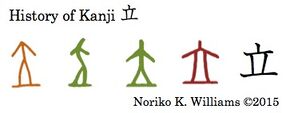Difference between revisions of "⽴"
(Created page with "⽴ X2F74 is Unicode character number 12148, KanjiRadical. ⽴ and two other unicode characters are qualified as Tatchi; they have similar grap...") |
|||
| Line 4: | Line 4: | ||
they have similar graphics, pronunciation and meaning. |
they have similar graphics, pronunciation and meaning. |
||
| − | <div style="float:right; margin:8px -14px 0px - |
+ | <div style="float:right; margin:8px -14px 0px -38px; background-color:#ffFFff"> |
<div style="margin:0px 0px 0px -8px"> |
<div style="margin:0px 0px 0px -8px"> |
||
[[File:TatchiDraw.png|300px]]<center> |
[[File:TatchiDraw.png|300px]]<center> |
||
| Line 41: | Line 41: | ||
Japanese names: たち、 たっ、 たつ、 だて、 つい |
Japanese names: たち、 たっ、 たつ、 だて、 つい |
||
</ref></center> |
</ref></center> |
||
| + | |||
| + | [[File:History-of-the-kanji-e7ab8b.jpg|290px|right]]<center> |
||
| + | Mnemonics by [[Noriko Williams]] <ref> |
||
| + | https://kanjiportraits.wordpress.com/tag/the-kanji-%E4%B8%A6/ The Kanji 立位泣粒並普譜 – Posture (2) Standard In the last post, we looked at the kanji that came from a front view of a person with hands and legs spread wide, which was 大. In this post we are going to look at the kanji that came from the same image except that it included the ground. A person, 大, and standing on the ground, 一, together became the kanji shape 立. (1) The kanji 立 “to stand” History of the kanji 立In the oracle bone style of the kanji 立, in brown, a man standing on the ground was viewed from the front. Where one stood in court signified his position or rank. From that it originally meant “position” and “to stand.” In bronze ware style, in green, the person on the left appeared to be twisting his body with his two feet apart. The sample on the right side had a person and the ground. In ten style, in red, the two standing legs were emphasized. The kun-yomi 立つ /ta’tsu/ means “to stand,” and is in 立ち上がる (“to rise up” /tachiagaru/), 目立つ (“to stand out” /meda’tsu/), 立場 (“standpoint; situation” /ta’chiba/) and 成り立ち (“beginning; origin” /naritachi/). Our Kanji Portraits blog examines kanji from the viewpoint of 漢字の成り立ち (“makeup of kanji; history of kanji” /kanji no naritachi/). The on-yomi /ri’tsu/ is in 直立 (“upright” /chokuritsu/), 立法 (“legislation; law making” /rippo’o/), 立派な (“praiseworthy; impressive” /rippa-na/). It has another on-yomi /ryu‘u/ in the word 建立する (“to erect a temple or shrine” /konryuu-suru/). (2) The kanji 位 “position; status; approximately; ranking” .. |
||
| + | </ref> |
||
| + | </center> |
||
</div></div> |
</div></div> |
||
==[[Tatchi]]== |
==[[Tatchi]]== |
||
Latest revision as of 17:14, 7 July 2021
⽴ X2F74 is Unicode character number 12148, KanjiRadical.
⽴ and two other unicode characters are qualified as Tatchi; they have similar graphics, pronunciation and meaning.
Tatchi
Word Tatchi is used in TORI to denote the following Unicode characters:
Name Tatchi, instead of Taci, Tachi and Tati, is chosen in order to avoid confusions with the already established terms:
https://en.wikipedia.org/w/index.php?title=TACI&redirect=no Transmembrane activator and CAML interactor
https://en.wikipedia.org/wiki/Tachi
https://en.wiktionary.org/wiki/太刀
https://ja.wiktionary.org/wiki/太刀 たち」参照。
https://en.wikipedia.org/wiki/Tati Tati can refer to: Film.. Locations.. Music.. Person.. asteroid.. languages..
Encoding
Alghough characters of Tatchi, id est, ⽴, 立, 立, look similar, they may be interpreted in different way by computers; in particular, at the search and replace commands; or even not supported at all. In order to handle these case, the knowledge of the encoding is helpful. The Utf8 encoding of Tatchi characters can be revealed with PHP program ud.t; file uni.t also should be loaded. Then, command
php ud.t 2F74 7ACB F9F7
produces the following output:
K= 4 2F74 12148 [[⽴]] ⽴ Unicode character number 12148 id est, [[X2F74]] Picture: [[⽴]] ; uses 3 bytes. These bytes are: XE2 XBD XB4 in the hexadecimal representation and 226 189 180 in the decimal representation 7ACB 31435 [[立]] 立 Unicode character number 31435 id est, [[X7ACB]] Picture: [[立]] ; uses 3 bytes. These bytes are: XE7 XAB X8B in the hexadecimal representation and 231 171 139 in the decimal representation F9F7 63991 [[立]] 立 Unicode character number 63991 id est, [[XF9F7]] Picture: [[立]] ; uses 3 bytes. These bytes are: XEF XA7 XB7 in the hexadecimal representation and 239 167 183 in the decimal representation
Phonetic
Tatchi characters can be pronounced "Tachi", たち.
However, sound たち may have also the other meaning, referring to a sword [6], special kid of katana (刀(かたな)) [7].
In order to avoid confusions, term Tatchi seems to be better as it does not allow transliteration into Hiragana, that could be confused with たち in various its meanings.
Nihongomaster
[8] suggest the following ways of the pronunciation:
リツ ,
リュウ ,
リットル ,
たつ ,
-たつ ,
たち- ,
たてる ,
-たてる ,
たて- ,
だて- ,
-たて ,
-だて ,
-だてる
Graphic
Image of Tatchi looks as superposition of
backslash and slash at the center and
horizontal line at the bottom.
Semantic
Nihongomaster [8] suggests the following meanings: stand up, rise, set up, erect, ..
Examples

立川 [11], prefecture near Tokyo (and, perhaps, the river (川), that crosses it).
Jisho [1] suggests the following examples:
On reading compounds
立案 【リツアン】 planning, devising (a plan), drafting, drawing up
立像 【リツゾウ】 standing statue, standing image
並立 【ヘイリツ】 standing abreast
不成立 【フセイリツ】 failure, rejection, rupture
立ち木 【タチキ】 standing tree, standing timber
立纓 【リュウエイ】 erect tail (of a traditional Japanese hat)
開立 【カイリュウ】 extraction of cubic root
造立 【ゾウリュウ】 erecting (temple, Buddhist statue, etc.)
Kun reading compounds
立つ 【たつ】 to stand, to rise, to stand up, to find oneself (e.g. in a difficult position), to depart (on a plane, train, etc.)
立つ瀬 【たつせ】 predicament, one's ground, one's position
突立 【とったつ】 stand straight up
立てる 【たてる】 to stand up, to put up, to set up, to erect, to raise, to thrust into, to bury into, to dig into, to make (a noise), to start (a rumour), to raise (a cloud of dust, etc.), to cause, to make, to establish, to set up, to develop, to formulate, to put up (a political candidate), to make (one's leader), to treat with respect, to give (someone) their due, to make (someone) look good, to avoid embarrassing (someone), to sharpen, to make clear, to shut, to close, to make tea (matcha), to perform the tea ceremony, to divide by, to do ... vigorously
Readings
Japanese names: たち、 たっ、 たつ、 だて、 つい
Nihongomaster [8] suggests the following examples: 立場, たちば standpoint, position, situation
立つ, 発つ, たつ to stand, to rise, to stand up, to find oneself (e.g. in a difficult position), to depart (on a plane, train, etc.)
連立, 聯立, れんりつ alliance, coalition
連立, 聯立, れんりつ alliance, coalition
成立, せいりつ coming into existence, arrangements, establishment, conclusion, completion, to come into existence, to be true, to hold (i.e. hold true)
独立, どくりつ independence (e.g. Independence Day), self-support
対立, たいりつ confrontation, opposition, antagonism
目立つ, めだつ to be conspicuous, to stand out
設立, せつりつ establishment, founding, incorporation (of a business)
国立, こくりつ national
References
- ↑ 1.0 1.1 https://jisho.org/search/%23kanji%20立 立 5 strokes Radical: stand, erect 立 Parts: 立 stand up, rise, set up, erect Kun: た.つ、 -た.つ、 た.ち-、 た.てる、 -た.てる、 た.て-、 たて-、 -た.て、 -だ.て、 -だ.てる On: リツ、 リュウ、 リットル Jōyō kanji, taught in grade 1 JLPT level N4 58 of 2500 most used kanji in newspapers Words starting with 立 Words ending with 立 Words containing 立 External links Stroke order On reading compounds 立案 【リツアン】 planning, devising (a plan), drafting, drawing up 立像 【リツゾウ】 standing statue, standing image 並立 【ヘイリツ】 standing abreast 不成立 【フセイリツ】 failure, rejection, rupture 立ち木 【タチキ】 standing tree, standing timber 立纓 【リュウエイ】 erect tail (of a traditional Japanese hat) 開立 【カイリュウ】 extraction of cubic root 造立 【ゾウリュウ】 erecting (temple, Buddhist statue, etc.) Kun reading compounds 立つ 【たつ】 to stand, to rise, to stand up, to find oneself (e.g. in a difficult position), to depart (on a plane, train, etc.) 立つ瀬 【たつせ】 predicament, one's ground, one's position 突立 【とったつ】 stand straight up 立てる 【たてる】 to stand up, to put up, to set up, to erect, to raise, to thrust into, to bury into, to dig into, to make (a noise), to start (a rumour), to raise (a cloud of dust, etc.), to cause, to make, to establish, to set up, to develop, to formulate, to put up (a political candidate), to make (one's leader), to treat with respect, to give (someone) their due, to make (someone) look good, to avoid embarrassing (someone), to sharpen, to make clear, to shut, to close, to make tea (matcha), to perform the tea ceremony, to divide by, to do ... vigorously Readings Japanese names: たち、 たっ、 たつ、 だて、 つい
- ↑ https://kanjiportraits.wordpress.com/tag/the-kanji-%E4%B8%A6/ The Kanji 立位泣粒並普譜 – Posture (2) Standard In the last post, we looked at the kanji that came from a front view of a person with hands and legs spread wide, which was 大. In this post we are going to look at the kanji that came from the same image except that it included the ground. A person, 大, and standing on the ground, 一, together became the kanji shape 立. (1) The kanji 立 “to stand” History of the kanji 立In the oracle bone style of the kanji 立, in brown, a man standing on the ground was viewed from the front. Where one stood in court signified his position or rank. From that it originally meant “position” and “to stand.” In bronze ware style, in green, the person on the left appeared to be twisting his body with his two feet apart. The sample on the right side had a person and the ground. In ten style, in red, the two standing legs were emphasized. The kun-yomi 立つ /ta’tsu/ means “to stand,” and is in 立ち上がる (“to rise up” /tachiagaru/), 目立つ (“to stand out” /meda’tsu/), 立場 (“standpoint; situation” /ta’chiba/) and 成り立ち (“beginning; origin” /naritachi/). Our Kanji Portraits blog examines kanji from the viewpoint of 漢字の成り立ち (“makeup of kanji; history of kanji” /kanji no naritachi/). The on-yomi /ri’tsu/ is in 直立 (“upright” /chokuritsu/), 立法 (“legislation; law making” /rippo’o/), 立派な (“praiseworthy; impressive” /rippa-na/). It has another on-yomi /ryu‘u/ in the word 建立する (“to erect a temple or shrine” /konryuu-suru/). (2) The kanji 位 “position; status; approximately; ranking” ..
- ↑ https://util.unicode.org/UnicodeJsps/character.jsp?a=2F74 ⽴ 2F74 KANGXI RADICAL STAND Han Script id: allowed confuse: 立 , 立
- ↑ https://util.unicode.org/UnicodeJsps/character.jsp?a=7ACB 立 7ACB CJK UNIFIED IDEOGRAPH-7ACB Han Script id: restricted confuse: ⽴ , 立
- ↑ https://util.unicode.org/UnicodeJsps/character.jsp?a=F9F7 立 F9F7 CJK COMPATIBILITY IDEOGRAPH-F9F7 Han Script id: allowed confuse: ⽴ , 立
- ↑ https://ja.wikipedia.org/wiki/太刀 太刀(たち)とは、日本刀のうち刃長がおおむね2尺(約60cm)以上で、太刀緒を用いて腰から下げるかたちで佩用(はいよう)するものを指す。刃を上向きにして腰に差す打刀とは「銘」を切る位置が異なるが、例外も数多く存在する。また、平均的な刃長は約80cmほどである。
- ↑ https://ja.wikipedia.org/wiki/刀 刀(かたな)は武器(刀剣)の一種であり、剣の内でもとくに片側にしか刃のない物を指す。切断力を増す為に反りのついた構造のものが多い。反りのついていないものは特に直刀と称する。日本語としては「かた・な」と分解できてそれぞれ片、刃をあらわす。日本の刀に関する詳細は日本刀の項を参照。 ..
- ↑ 8.0 8.1 8.2 https://www.nihongomaster.com/dictionary/kanji/2829/立 立 5 Strokes JLPT Level 5 Definition of 立 stand up rise set up erect ..
- ↑ 日本語: ミドリガ池から望む立山 Date 14 July 2018, 16:43:48 Source Own work Author Saigen Jiro
- ↑ https://ja.wikipedia.org/wiki/立山 立山 (たてやま)
- ↑ https://ja.wikipedia.org/wiki/立川 (たちかわ、たぢかわ、たつかわ、たてかわ)とは次の意味である。ここでは特筆がないものは全て「たちかわ」と読む。..
Keywords
Tatchi is used in TORI to denote the following Unicode characters:
Japanese, Kanji, KanjiConfudal, KanjiLiberal, KanjiRadical, PHP, ud.t, Uni.t, Unicode, Utf8 X2F74 ⽴ , X7ACB 立 , XF9F7 立 ,

